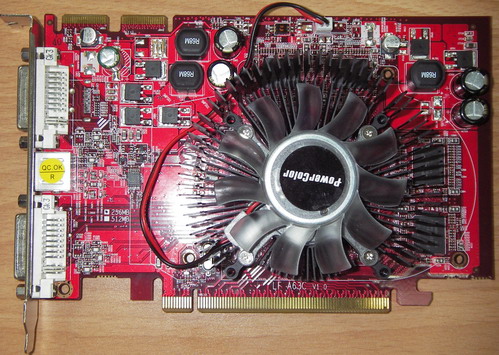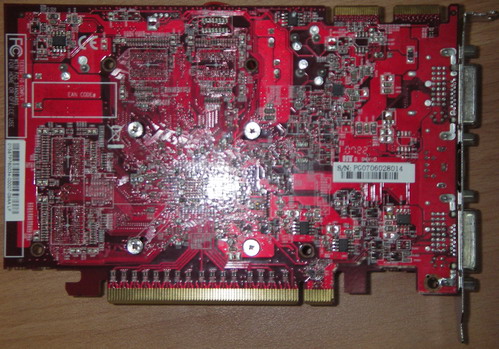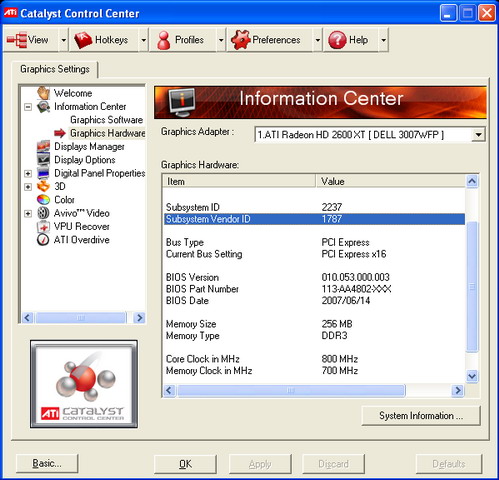So here it is, the heavily delayed Radeon HD 2600 XT from AMD, but the question that we have all been wondering about is if it is any good. Well, you’re going to have to wait a little bit longer for the answer to that question, but let’s start with a closer look at the specifications of this puppy. We tested a card from PowerColor and as all board partners are free to do their own designs on these cards, expect to see slightly different looking cards.
This first generation from PowerColor follows the reference design, it is not quite the same, although you can see the outline for the reference cooler on the board, but PowerColor has gone with a different cooling solution. The cooler PowerColor has used is somewhat similar to a Zalman cooler, but with less fins. Judging by how cool the card was running during testing, it seems to do more than an adequate job.

The card doesn’t feature an additional power connector, so there might be a limitation on how far you can overclock this card. Due to our very limited time to play with this card, we only took a pot shot at overclocking it, but more on this later on. The default clocks speeds for the PowerColor card was 800MHz for the GPU and 700MHz for the GDDR3 memory or 1,400MHz effectively. Nothing out of the ordinary here and PowerColor used 1.4ns memory modules from Hynix. This means that there isn’t much headroom in terms of overclocking, although this will as always depend on how lucky you are.
The Radeon HD 2600 XT GPU has 120 stream processors and sadly a 128-bit memory interface, but this information had been widely available for quite some time. It also has eight texture units and four ROPs, although AMD calls these render back-ends. The core is made up of some 390 million transistors, some 310 million short of a Radeon HD 2900 XT. It will be interesting to see how overclockable these parts are, as at 65nm the Radeon HD 2600 XT should run very cool.
The PowerColor card features two DVI ports and a TV-out connector as well as two hardware CrossFire connectors on the top of the PCB. Apart from this there’s very little that catches the eye. It looks like a 512MB version will be out soon as well, as the card has a tick box for 512MB and four empty memory spaces on the rear of the card. 512MB cards weren’t on AMD’s roadmap, but as these cards are built by the partners, ATI doesn’t have too much say in what can or can’t be done.

As with the Radeon HD 2900 XT the HD 2600 XT supports HDMI out via a DVI to HDMI dongle and the HD 2600 XT has the same audio drivers. One difference here is that the HD 2600 and HD 2400 series does UVD in hardware instead of in software as per the HD 2900 XT. This is something we’ll look at in the future, as we didn’t have any high definition content available to us at the time of testing.
So, onwards to what you all have been waiting for, the benchmarks. Does the Radeon HD 2600 XT live up to its expectations? Well, that depends on what you expect from a graphics card that should retail for around €110-130. The test system we used didn’t have Windows Vista installed on it, so you’ll have to be patient and wait for Sanjin to bring you DX10 numbers as soon as we get a card to the labs. But as a DX9 card, it performs quite well considering the lower than expected retail price.
Is it going to beat Nvidia? Well, not if you’ve already got a GeForce 8600 GTS, but it will definitely put up a battle against the 8600 GT. It will also kick the crap out of some older ATI cards like the X1650 series and even the low end X1800 cards in some games, depending on the resolution. It won’t beat the X1950 Pro though, due to the X1950 Pro’s 256-bit memory interface. It is a worthwhile upgrade if you have an older ATI card and have decided to stick with ATI, it’s also a worthy option over a GeForce 8600 GT, so it really comes down to what brand you prefer.
So what about some benchmark figures? Well, we weren’t able to run all of our standard benchmarks, partly due to time restrictions and partly due to the fact that we tested the card in PowerColor’s offices in Taiwan. This makes things slightly more difficult when it comes to comparing results. Although the system we tested the card on is similar to the system that Sanjin uses, it’s not the same spec.
The test system had an Intel Core 2 Extreme X6700 CPU, 2GB of DDR2 at 1066MHz and a DFI Lanparty UT ICFX3200-T2R/G motherboard with the ATI RD600 chipset. Not a bad machine and the results are in the general ballpark of what we would get on our test system. It was actually the same system we helped PowerColor tweak during Computex, but with a different CPU in it. We used the 8.39 rc4 drivers, which should be quite similar to the recently released Catalyst 7.6 drivers.

First up we have 3DMark 05
| 3DMark 05 | ||||
| Overall | GT1 | GT2 | GT3 | |
| 1,024x768 | 9670 | 41.6 | 30.4 | 45.7 |
| 4xFSAA | 6810 | 30.4 | 20.4 | 32.7 |
| 850/750 | 10240 | 44 | 32.1 | 48.6 |
| 1,280x1,024 | 8052 | 34.6 | 25.2 | 38.4 |
| 4xFSAA | 5385 | 23.9 | 16.1 | 25.9 |
| 1,680x1,050 | 6841 | 29.4 | 21.2 | 32.9 |
| 4xFSAA | 4461 | 19.8 | 13.2 | 21.8 |
| 1,920x1,200 | 5958 | 25.3 | 18.5 | 28.9 |
| 4xFSAA | 3784 | 16.6 | 11.3 | 18.5 |
This is the only test we had time to give a quick run with the card overclocked and a 50MHz overclock for the core and the memory has to be considered pretty good considering we didn’t spend any time trying to get the most out of this card. The performance increase is rather small, although it is large enough to make it worthwhile. It’s still shy of beating a GeForce 8600 GTS, but the GT doesn’t stand a chance, even at default speeds.
As for the test results, we only had time to test he card with 4xFSAA enabled, due to the time it takes to run all the tests. As we had a wide screen display at our disposal, we decided to run the high resolution tests at wide screen resolutions, as this is meant to be a graphics card for the wide screen HD generation. 1,680x1,050 is most likely going to be the result most people care about once you move past 1,280x1,024 as you can pick up a 20 or 22-inch LCD screen for very little money these days.
The card really starts to struggle once you pass 1,680x1,050 and it doesn’t seem like 4xFSAA being enabled either. This is most likely related to the 128-bit memory interface, as there just isn’t enough data being shifted between the GPU and the memory for FSAA to work at its best.
Next up we have 3DMark 06
| 3DMark 06 | |||||
| Overall | GT1 | GT2 | HDR1 | HDR2 | |
| 1,024x768 | 5916 | 13.8 | 17.18 | 22.58 | 30.27 |
| 4xFSAA | 4242 | 11.15 | 12.33 | 17.59 | 16.65 |
| 1,280x1,024 | 4802 | 11.74 | 14.55 | 17.68 | 22.18 |
| 4xFSAA | 3238 | 9.19 | 9.79 | 12.26 | 11.68 |
| 1,680x1,050 | 4063 | 10.15 | 12.44 | 14.79 | 17.7 |
| 4xFSAA | 2629 | 7.76 | 8.09 | 9.81 | 8.68 |
| 1,920x1,200 | 3502 | 8.95 | 10.93 | 12.54 | 14.45 |
| 4xFSAA | 2228 | 6.6 | 6.98 | 7.89 | 7.37 |
Again, the card has the same issues with 4xFSAA, although it’s still lagging behind the 8600 GTS, it’s ahead of the GT again. Nothing much else to say here really, the numbers speaks for themselves.
Let’s move on to Company of Heroes
| Company of Heroes | |||
| avg | max | min | |
| 1,024x768 | 75.9 | 153.6 | 34.3 |
| 1,280x1,024 | 55.7 | 113.4 | 21.9 |
| 1,440x900 | 44.4 | 93 | 20.6 |
| 1,680x1,050 | 35.8 | 75 | 14.7 |
| 1,920x1,200 | 29.5 | 59.4 | 12.2 |
The numbers looks pretty solid here all the way through to 1,920x1,200, as in this strategy game you’ll do just fine around 30fps. It even manages to beat a GeForce 8600 GTS here at lower resolution and you really have to crank up the resolution before the Radeon HD 2600 XT takes a beating here.
One problem we encountered was that 4xFSAA didn’t work in Company of Heroes, although this is most likely a driver issue. Hopefully this is something AMD will resolve, although, if CoH takes as much of a performance penalty as the other tests, it might not be worth the effort to enable it.
Finally we have F.E.A.R.
| F.E.A.R. | |||
| avg | max | min | |
| 1,024x768 | 73 | 152 | 40 |
| 4xFSAA | 36 | 88 | 12 |
| 1,280x1,024 | 49 | 102 | 26 |
| 4xFSAA | 24 | 60 | 7 |
| 1,680x1,050 | 37 | 76 | 20 |
| 4xFSAA | 18 | 51 | 6 |
| 1,920x1,200 | 30 | 61 | 16 |
| 4xFSAA | 14 | 48 | 5 |
The results here are nothing short of disappointing, as the Radeon HD 2600 XT takes a real beating here. It is only ahead at 1,024x768, anything higher than that and even the 8600 GT beats it. Still, the game is just about playable at 1,920x1,200, so we can’t complain too much.
Conclusion
So there you have it, our first review of a Radeon HD 2600 XT with GDDR3 memory. Is it worth getting one? Well, it depends on your preferences and how much or how little money you want to spend. It’s not a bad graphics card and although we have yet to take a closer look at the UVD features and HDMI over DVI, this card should prove to be a good mid-price buy. It’s cheaper than a GeForce 8600 GT, although this might not be the case for long and it performs better in most circumstances. Overclock it a little bit and it gets even better, but still not at GeForce 8600 GTS beater, maybe the GDDR4 version can manage this.
We’d also like to thank PowerColor for letting us test this card in their offices and for the time they took to help us get this review done.

